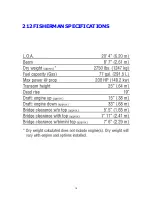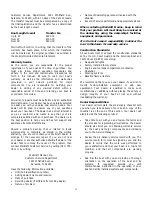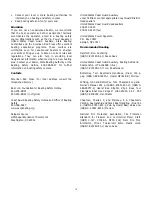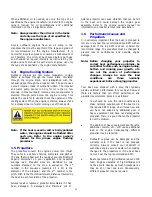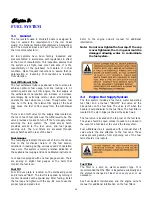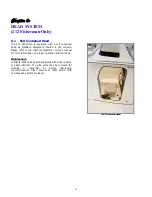
1.7
Engine Instrumentation
The helm station is equipped with a set of engine
instruments and/or alarms. These instruments allow the
operator to monitor the engines’ operational conditions.
Close observation of these instruments allows the
operator to operate the engine at the most efficient level
and could save them from serious costly damage. The
instrumentation is unique to the type of outboard motor
installed on your boat. Some or all of the following
gauges may be present.
Tachometer
The tachometer displays the speed of the engine in
revolutions per minute (RPM). This speed is not the boat
speed or necessarily the speed of the propeller. The
tachometer may not register zero with the key in the
“OFF” position.
Speedometer
The speedometer indicates the speed of the boat in miles
per hour. Most speedometers measure the water
pressure against a small hole in a pickup located in the
engine lower unit or mounted on the bottom of the
transom.
Temperature Warning
The temperature warning indicates the temperature of
the engine. A sudden increase in the temperature could
indicate an obstructed water inlet or an impeller failure.
Water Pressure Gauge
The water pressure gauge indicates the pressure in the
engine cooling system that is generated by the cooling
pump. The water pressure indicated when the engine is
new is usually the reference for normal water pressure
for that engine. Refer to the engine manufacturer
owner’s manual for more information on the cooling
system water pressure requirements for your engine.
A drop in water pressure is a possible indication of water
pump problems or a blocked intake. Excessive pressure is
a possible indication of an internal blockage. Unusually
high or low water pressure should be investigated and
corrected immediately.
Oil Pressure Gauge
The oil pressure gauge monitors the engine lubrication
system pressure on boats with 4-cycle engines. The oil
pressure indicated when the engine is new is usually
the reference for normal oil pressure for that engine. A
drop in oil pressure is a possible indication of oil pump
problems, a leak or fuel diluted oil.
Fuel Gauges
The fuel gauge indicates the amount of fuel in the
tank.
Refer to the engine or gauge manufacturer owner’s
manual for detailed information on the gauge installed
in your boat.
Voltmeter
The volt meter displays the voltage for the battery and
the charging system. The normal voltage is 11 to 12-
volts with the engines off, and 13 to 14.5 volts with
the engines running.
Engine Tilt/Trim Gauge
The tilt/trim gauge monitors the position of the
outboard engine. The upper range of the gauge
indicates the tilt, which is used for trailering and
shallow water operation. The lower range indicates the
trim position. This is the range used to adjust the hull
angle while operating your boat on plane. Please refer
the engine owner’s manual for more information on
the operation of the outboard power tilt and trim.
Engine Alarms
Most outboards are equipped with an audible alarm
system mounted in the helm area that monitors
selected critical engine systems. The alarm will sound
if one of these systems begins to fail. Refer to the
engine owner’s manual for information on the alarms
installed with your engine.
24
Summary of Contents for 180 Sportsman
Page 2: ...2...
Page 4: ...4...
Page 7: ...180 FISHERMAN SPECIFICATIONS 7...
Page 8: ...180 SPORTSMAN SPECIFICATIONS 8...
Page 9: ...202 FISHERMAN SPECIFICATIONS 9...
Page 10: ...212 FISHERMAN SPECIFICATIONS 10...
Page 18: ...18...
Page 39: ...SAFETY LABELS 2601 1124 39...
Page 40: ...180 FISHERMAN 180 SPORTSMAN CAPACITY LABELS 40...
Page 41: ...202 212 FISHERMAN CAPACITY LABELS 41...
Page 61: ...Appendix A SCHEMATICS 180 FISHERMAN INSTRUMENT PANEL 61...
Page 62: ...Appendix A SCHEMATICS 180 SPORTSMAN INSTRUMENT PANEL 62...
Page 63: ...Appendix A SCHEMATICS 202 212 FISHERMAN INSTRUMENT PANEL 63...
Page 68: ...Appendix A SCHEMATICS 180 FISHERMAN 180 SPORTSMAN TRAILER DRAWING 68...
Page 69: ...Appendix A SCHEMATICS 202 212 FISHERMAN TRAILER DRAWING 69...
Page 70: ...Appendix A SCHEMATICS 180 FISHERMAN OVERHEAD LAYOUT 70...
Page 71: ...Appendix A SCHEMATICS 180 SPORTSMAN OVERHEAD LAYOUT 71...
Page 72: ...Appendix A SCHEMATICS 202 FISHERMAN OVERHEAD LAYOUT 72...
Page 73: ...Appendix A SCHEMATICS 212 FISHERMAN OVERHEAD LAYOUT 73...
Page 77: ...MAINTENANCE LOG 77...
Page 78: ...MAINTENANCE LOG 78...
Page 80: ...Appendix D BOAT ACCIDENT REPORT 80...
Page 81: ...81...
Page 87: ...Appendix F TROUBLESHOOTING GUIDE 87...
Page 88: ...TROUBLESHOOTING GUIDE 88...
Page 89: ...TROUBLESHOOTING GUIDE 89...
Page 90: ...TROUBLESHOOTING GUIDE 90...
Page 91: ...TROUBLESHOOTING GUIDE 91...

